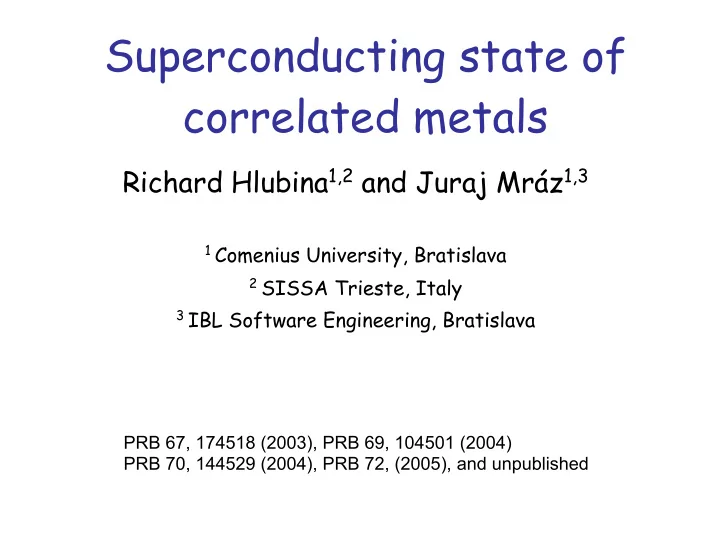

Superconducting state of correlated metals Richard Hlubina 1,2 and Juraj Mráz 1,3 1 Comenius University, Bratislava 2 SISSA Trieste, Italy 3 IBL Software Engineering, Bratislava PRB 67, 174518 (2003), PRB 69, 104501 (2004) PRB 70, 144529 (2004), PRB 72, (2005), and unpublished
Outline 1. Motivation 2. Systematic corrections to the mean field theory in the p-p and p-h channels Applications: 3. Superconducting phase diagram of the t-t’ Hubbard model d-wave region: bilayer p-wave region: Sr 2 RuO 4 4. Van Hove density: p-p vs. p-h competition 5. Retardation effects
1. What are the distinguishing features of the superconducting state of doped Mott insulators? pairing symmetry………………………d-wave also at weak coupling! particle-hole asymmetry…………? reduced phase stiffness…………Josephson effect (RH, Hvar ‘02) frequency dependence of Δ ……difference w.r.t. phonons? ??? Our program Hypothesis: supercond. in cuprates = giant Kohn-Luttinger effect Strategy: approach from overdoped side; search for new features Byproduct: application to Sr 2 RuO 4
2. Systematic corrections to the mean field theory Particle-particle channel Particle-hole channel at q=( π , π ) Particle-hole channel at q=0
1. split the Hamiltonian Kinetic energy 2. canonical transformation LARGE! SMALL! (can be treated by mean field) 3. resulting Hamiltonian where
BCS channel Density wave channel Landau channel
Density wave channel Order parameters Variational energy where particle-particle susc.
Gap functions SDW case: 4-vector 4x4 matrix unitary state: eigenvalues gap equation: (unitary states)
Classification of symmetry breaking solutions Channel: BCS, density wave, Landau Spin sector: singlet,triplet Orbital sector (2D square lattice): s, d, d xy , g, p Charge density wave channel: (Hankevych,Wegner, EPJ ’03) Spin density wave channel: (“axial” states)
3. Superconducting phase diagram of the t-t’ Hubbard model
(U infinitesimal) cuprates Sr 2 RuO 4 ρ t’/t
Transition temperatures for singlet and triplet pairing t’/t=0.35, U=6t, 512x512
Triplet-singlet mixing pure Mixed phase pure p-wave d xy -wave ρ 0.6 0.645
Mixed phase – correlation functions
4. Competition between particle-particle and particle-hole instabilities at the Van Hove density ρ t’/t
t’/t=0.0, Van Hove density, 128x128
s-SDW p-CDW d-SC, d-SDW, d-CDW Gap functions for U=3t t’/t=0, ρ =1, 128x128 Degenerate states (Hankevych, Wegner)
t’/t=0.05, Van Hove density, 128x128
t’/t=0.10, Van Hove density,128x128
t’/t=0.20, Van Hove density, 128x128
Van Hove phase diagram, U=3t ρ SD SC W (absent in mean field!) t’/t
5. Retardation effects
Hubbard-Holstein model Scattering terms
Eliminate scattering terms: Effective interaction in the Cooper channel:
D/t=0.4, ω 0 /t=0.2, Γ /t=0.02 2D 2 / ω 0 =1.6t
Gap function U=0 U=3t
Gap function along (0,0) to ( π , π ) Fermi surface gap momentum
Cooper pair wavefunction U=0 U=6t
Cooper pair wavefunction el.-el. distance
Conclusions methodology: • simple ‘variational’ method allowing comparison of different • symmetry breaking patterns on the same footing applications: • fully microscopic model for the T c enhancement on a bilayer • t-t’ Hubbard model: a possible canonical model for p-wave • superconductivity in Sr 2 RuO 4 correlation effects: • additional structure due to Hubbard U in Δ ( ω ) of the Holstein • model retardation effects in the d-wave sector: work in progress • observability of the structure?? •
Recommend
More recommend